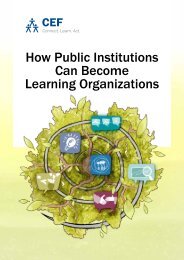CEF Annual report 2021
Create successful ePaper yourself
Turn your PDF publications into a flip-book with our unique Google optimized e-Paper software.
68 <strong>CEF</strong> FINANCIAL REPORT <strong>2021</strong><br />
NOTES TO THE FINANCIAL STATEMENTS 69<br />
Cash and cash equivalents<br />
Cash and cash equivalents include cash in hand and sight deposits.<br />
Financial and operating liabilities<br />
Other financial and operating liabilities are initially recognized at fair value on the day they arise,<br />
and afterwards at amortized cost, using the effective interest rate method.<br />
Liabilities are only derecognized if they have been extinguished, meaning that they have been<br />
fulfilled. The difference between the carrying amount of liabilities that have been extinguished<br />
and the consideration paid (including non-monetary assets or assumed liabilities) is recognized<br />
immediately in the profit or loss account.<br />
Share capital<br />
Share capital is the capital contributed by the founder. The <strong>CEF</strong>’s total equity comprises capital<br />
and capital surplus.<br />
General reserves<br />
As envisaged in Article 17 of the <strong>CEF</strong> Financial Rules and Regulations, general reserves are created<br />
to cover the annual running costs of the <strong>CEF</strong> and its core program and shall amount at least<br />
to the total sum of one million euro. Financial result of the year shall be transferred to the general<br />
reserves, unless otherwise decided by the Governing Board.<br />
(C) PROPERTY, PLANT AND EQUIPMENT<br />
Recognition and measurement<br />
Items of property, plant and equipment are disclosed at historical cost, less depreciation costs<br />
and impairment losses.<br />
Costs of assets produced comprise the costs of materials, direct costs of labor, other costs that<br />
can be directly attributed to enabling the use of assets for their intended purpose, costs of disposal<br />
and removal, costs of restoring the location of the asset to its original state, and capitalized<br />
borrowing costs.<br />
Any computer software that contributes significantly to the assets’ functionality should be capitalized<br />
as part of these assets.<br />
Components of items of property, plant and equipment that have different useful lives are accounted<br />
for as separate items.<br />
Subsequent costs<br />
Costs arising from the replacement of parts of fixed assets are recognized at carrying value if<br />
future economic benefits associated with a part are likely to increase and if its historical cost can<br />
be measured reliably. All other costs (such as daily maintenance) are recognized as expenses in<br />
the income statement in the period they arise.<br />
Spare parts<br />
Spare parts and maintenance equipment of lower value with useful lives of up to one year are<br />
treated as inventory and recognized as costs in the income statement. Spare parts and equipment<br />
of significant value with estimated useful lives exceeding one year are recognized as items<br />
of property, plant and equipment.<br />
Depreciation<br />
Depreciation is calculated using the straight-line method based on the useful life of each component<br />
of an item of property, plant and equipment. This is the most accurate method for predicting<br />
asset usage patterns.<br />
Estimated useful lives for the current and comparative period are as follows:<br />
Depreciation rates <strong>2021</strong> 2020<br />
Computer equipment, mobile phone, copy machine 2–3 years 2–3 years<br />
Investment in premises 33 years 33 years<br />
Other equipment 3–5 years 3–5 years<br />
Depreciation methods, useful lives and residual values are reviewed at the end of the <strong>report</strong>ing<br />
period and adjusted if necessary. No changes in recording depreciation were applied in <strong>2021</strong>.<br />
(D) INTANGIBLE ASSETS<br />
Other intangible assets<br />
Other intangible assets with limited useful lives are disclosed at historical cost, less amortization<br />
costs and accumulated impairment losses.<br />
Subsequent costs<br />
Subsequent costs associated with intangible assets are only capitalized if they increase future<br />
economic benefits arising from the asset to which the cost is related. All other costs are recognized<br />
as expenses in the income statement when they arise.<br />
Amortization<br />
Amortization is calculated based on an asset’s purchase value or another value that is used<br />
instead. Amortization is recognized in the income statement using the straight-line method and<br />
is based on the useful life of intangible assets, starting from the date the asset is available for<br />
use. This is the most accurate method for predicting the patterns of future economic benefits<br />
associated with the asset.<br />
Estimated useful lives for the current and comparative year are as follows:<br />
Amortization rates <strong>2021</strong> 2020<br />
Software 2–3 years 2–3 years<br />
Other intangible assets 2–3 years 2–3 years<br />
Amortization methods, useful lives and other values are reviewed at the end of each business<br />
year and adjusted if necessary. No changes in recording amortization were applied in <strong>2021</strong>.
















